If you are reading these rules for the first time, ignore the text along the right hand side. These rules serve as a summary to help you quickly familiarize yourself with the game.
1.0 INTRODUCTION
In Germany in 1888, Bertha Benz, wife of auto pioneer Carl Benz,
undertook the first cross-country drive in an automobile. While
making the trek from Mannheim to Pforzheim, her car ran out
of fuel in Wiesloch. Mrs. Benz stopped into the city drugstore to
obtain the appropriate chemicals to make more fuel, effectively
creating the world´s first gas station.
The automobile (”Kraftwagen”) quickly became a common means
of transportation. The first Grand-Prix races at Nurburgring and
AVUS began around the same time period.
By 1928, Germany possessed a dense road network. Combustion
engines had triumphed over electric and steam engines and
cars were produced via assembly lines. Manufacturers began
producing more affordable vehicles for the broader population.
In Kraftwagen, players take on the role of owners of start-up
companies during the time period when cars came to maturity in
Germany and Europe.
2.0 GAME COMPONENTS
Each Kraftwagen copy contains:
- 1 gameboard
- 4 player mats
- 41 car body tiles
- 39 engine tiles
- 8 buyer tiles
- 50 research cards (9 engineers, 9 instant actions, 32 developments)
- 9 engineer markers
-
56 price markers (8 each in orange, purple and blue for the 3
game turns, plus 32 white markers)
- 10 action tiles
- 56 “workers” (14 each in the four player colors)
- 4 cars (1 each in the four player colors)
- 1 marker token (black)
- 4 start tiles
- 10 award tiles
- 12 specialty tiles
2.1 Gameboard
The gameboard is divided into several different areas. The action
track is the central element – here the players determine the
action(s) of their player turn and the play order. Each game turn,
the players conduct a car race on the Grand-Prix track.
The players offer cars they have produced onto the market. The
market can absorb a total of six cars each turn.
The buyer track may determine the end of the action phase and
the start of the scoring phase.
During each game turn, players will determine the 4 available
buyers for up to 6 cars players offered to the market.
Players will receive development points via research for new and
improved car bodies and engines as well as instant advantages and
famous engineers.
Finally, award tiles may be won by the players upon
accomplishing various goals.
2.2 Player Mats
The play mat of each player contains three workshops. In each
workshop there may be only one engine or one car body.
The Grand-Prix car space is in the top left portion of the mat. Here
one level “1” engine is depicted as part of the Grand-Prix car. The
Grand-Prix car is only used for the Grand-Prix race.
In the canteen each player places his available workers that will be
used for research and for selling cars.
2.3 Car Body Tiles
The car bodies have values of 1 to 7. The higher the value,
the bigger, more beautiful or more modern the car
body. The players may take car bodies of a higher
value only when they have completed enough research.
2.4 Engine Tiles
The engines also have values of 1 through 7. The higher the value, the better the
performance of the engine. Similar to car bodies, the players may take engines of
a higher value only when they have completed enough research.
2.5 Action Tiles
The action tiles depict one to three actions that are performed by
the players after they have chosen a tile on the action track.
2.6 Buyer Tiles
The Kraftwagen-buyers have four different preferences: car body
(look of the car), engine (performance), prestige, and price.
2.7 Start Tiles
At the start of the game each player chooses a start tile. Each tile
has slightly different start capabilities. The flipside of the tiles
depict identical developments (one development point each for
car body and engine).
2.8 Research Cards
The research cards represent the development of “better“ and
more modern car bodies and engines, instant cards for one-time
advantages, and famous engineers who help the players in
various ways.
2.9 Engineer Markers
Most of the engineer research cards have markers for their special abilities. If
a player chooses one of these research cards, he receives the respective
engineer marker(s).
2.10 Price Markers
The colored price markers are chosen by the players
to determine the market prices they would like to set
for their cars. The white price markers are given to
the players for taking certain actions and for
accomplishments in the Grand-Prix race.
Players should flip the price markers they have
collected to keep them hidden from their opponents.
2.11 Workers and Cars
Players will use their workers for various actions and to record
information. The cars are used in the Grand-Prix races.
2.12 Award Tiles
During the game players earn award tiles immediately upon achieving specific goals.
2.13 Marker Token
The marker token is used on the buyer track and marks
a possible end of the action phase.
In Kraftwagen players advance the state of automobile
development and production by playing as start-up companies.
They must research new technologies and build improved
chassis and engines. Early Grand-Prix races provide the young
companies with prestige and money, but the players must
maintain a key balance of fulfilling the demand preferences of
buyers at the lowest possible price.
The player who has the most money after three game turns is
the winner and will be mentioned in the same breath as
Daimler, Benz, and Opel.
One player puts the gameboard on the table. The action tiles
are placed face-up on consecutive spaces of the action track (one
tile per space). First, all tiles with one action are placed, then
all tiles with two actions, and finally the tile with three actions.
The order of tiles within a category is randomized.
All research cards are shuffled and placed face-down on the
upper space in the research area of the board. The top two
cards are drawn and placed face-up in the two spaces below the
research card deck.
The eight buyer tiles are sorted by preference and placed face-up
on their respective spaces on the gameboard. The marker token
is put on space “S” of the buyer track.
The award tiles are put on their spaces on the gameboard.
One player sorts and stockpiles the following components next
to the game board, forming the supply:
- price markers according to color;
- car body and engine tiles according to value;
- 9 engineer markers;
- 14 workers of each player.
The four start tiles are placed next to the board.
Each player takes a player mat and four workers of one color
from the supply. The workers are placed in the canteen on his
mat. The Grand-Prix car has an engine value of “1” at the start of
the game.
The cars are placed in the pit lane of the race track; each player
takes a worker from their supply and places it as a marker on the
“0 laps” space.
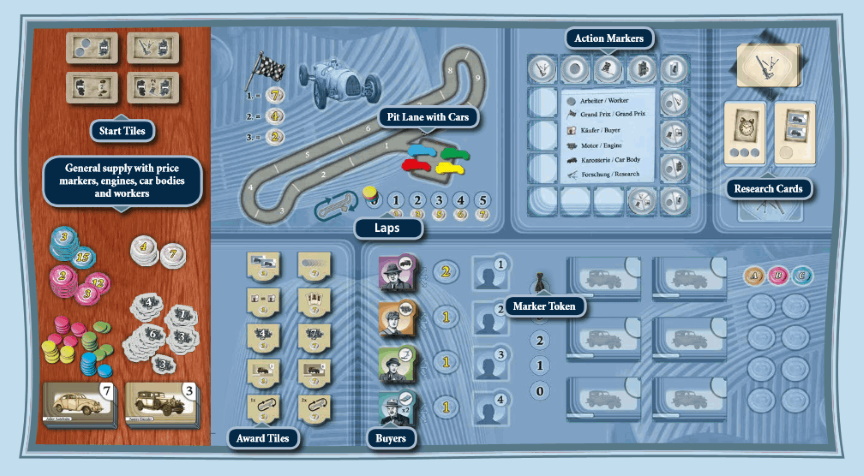
One worker of each player is taken from the supply
and placed, in random order, in the spaces directly behind the
last action marker. The start player is the player whose worker is
farthest away from the last action marker.
Now the starting positions of the players on the action track are
determined. One worker of each player is taken from the supply
and placed, in random order, in the spaces directly behind the
last action marker. The start player is the player whose worker is
farthest away from the last action marker.
In reverse order each
player takes one of the four start tiles and immediately
performs the actions on the tile.
In reverse order, beginning with the player whose
worker is directly in front of the last action marker, each
player takes one of the four start tiles and immediately
performs the listed actions. These are
identical to actions during the game
and are explained in the action phase in detail below.
Special Start Tiles
Grand-Prix – 2 spaces (start tiles only)
The player places his car directly on space 2 of
the Grand-Prix track (instead of in the pit).
This action is only on one of the start tiles.
Grand-Prix car – Engine 2 (start tiles only)
The player takes an “engine 2” from supply and
places it on top of the “engine 1.”
This action is only on one of the start tiles.
Important:
The player is still considered to have
only one research point in the engine category.
Afterwards, each player flips his chosen start tile
so the development side is up – each player starts with
a development level of 1 for both their car engine and car body.
Example: Marion receives the last start tile as start
player. She begins the game with two additional
workers in the canteen and an engine
of value “1” in one of her workshops.
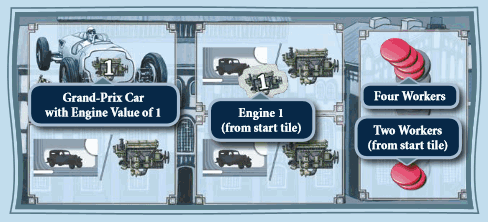
In a 3-player-game the components of the fourth player (player
mat, car, 14 workers, and the surplus start tile) are put back into
the game box.
Note: In a 2-player Kraftwagen game the rules are slightly
modified, see 8.0.
5.1 Preparation
At the start of a game turn:
-
Place the orange, purple or blue price markers in the market for game turns 1, 2 and 3, respectively.
-
On the four spaces next to the four buyer stacks add a white price
marker of value “1” (preferences engine, prestige, price)
or value “2” (preference car body).
At the start of the game turn the respective colored price markers are
placed on their spaces on the market.
Turn 1: orange price markers (values 1, 2, 3, 5, 6, 8, 9, 10)
Turn 2: purple price markers (values 2, 3, 5, 6, 8, 9, 11, 12)
Turn 3: blue price markers (values 3, 4, 6, 8, 10, 12, 14, 15)
The four spaces next to the four buyer stacks receive a white price
marker of value “1” (preferences engine, prestige, price) and a
white price marker of value “2” (preference car body). Even if
there are still one or two price markers from earlier turns, another
corresponding marker is added.
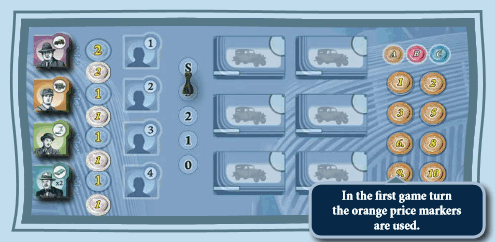
5.2 Action Phase
Players conduct their player turns until
six automobiles have been placed on
the market or the marker token on the buyer track has reached
space 0.
Kraftwagen is not
played with a fixed turn order. The player whose worker is at the end of
the chain of workers and action tiles takes the next player
turn.
In this phase the players conduct their player turns. The action
phase ends when a total of six automobiles have been placed on
the market or the marker token on the buyer track has reached
space 0.
Note: In contrast to most other games, Kraftwagen is not
played with a fixed turn order. The player whose worker is at the end
(i.e. the farthest counter-clockwise)
of the chain of workers and action tiles conducts his player
turn. (In the beginning this is the start player). Depending on
which tiles are chosen the players may have a different number
of turns during a game. Moreover, it is possible that a player
performs several turns in a row if still last in the chain.
There is a continuous chain on the action track consisting
of players' workers and the 10 action tiles. The front
(farthest clockwise) and end (farthest counter-clockwise)
of the chain are separated by a gap. The chain is never split.
Any action tiles at the end of the chain after a player´s turn are
immediately placed at the front of the chain.
There is a continuous chain on the action track consisting
of the workers of the players and the 10 action tiles. The front
(farthest clockwise) and end (farthest counter-clockwise)
of the chain are separated by a gap. The chain always
stays together and is never split. If there should be an action
tile at the end of the chain after a player´s turn, this tile is
immediately placed at the front of the chain (if necessary, this
is done several times until a worker is at the end of the chain).
A player turn consists of two phases which must be conducted in this order:
-
Choose an action tile and conduct the action(s) (mandatory)
-
Place an automobile on the market (optional)
I. Choose an action tile and conduct the action(s)
The player may choose any action tile. He moves his
worker to the position of the action tile and
moves the tile to the front of the chain.
Each action tile contains one to three actions. If possible, the
player must conduct all actions on the chosen tile.
He may conduct them in any order.
The player may choose any action tile in the chain. He moves his
worker clockwise to the position of the chosen action tile and
then moves the tile to the front of the chain. In this way, the gap
between the front and end of the chain advances by one space in
a clockwise direction.
Each action tile contains one, two, or three actions. If possible, the
player must conduct all actions on the chosen tile. He may choose
the order in which to conduct the actions. However, he may only
start a new action once he has completed the former one.
Example: Marion is the last one in the chain, therefore it is her
turn. She chooses the Grand-Prix tile in front of here, moves her
worker to its space, and conducts the Grand-Prix action. Afterwards
she moves the tile to the front of the chain. Marion is still last in the
chain, so she takes another player turn. Marion takes the Grand-Prix
+ Buyer tile.
At the end of the actions of both of her turns Marion may move one
car each to the market (two total in this example); see the picture.
Actions in Detail:
Hire Worker
The player takes one of his workers from the supply.
The player takes one of his workers from the
supply and puts it into his canteen. If he
already has employed all of his workers, the action is forfeited.
Research
The player takes one of the two face-up
research cards and discards the other.
Draw two new research cards to replace them.
The player takes one of the two face-up
research cards. The other card is placed on the
discard pile; then two new research cards are
drawn and placed face-up on their spots.
Note: If the draw deck is empty a player
shuffles the discard pile to form a new draw deck.
There are three kinds of research cards: instant
actions, engineers and developments.
Car Body
The player takes a car body having a level equal to
the number of car body research points he has
and places it into an empty workshop.
If he has no empty workshops then
he must discard a car body or engine to empty one.
The player takes a car body tile according
to the number of research points he has in
this category and places it into an empty
workshop. If there are already car bodies or
engines in all three of his workshops then he
must return an old car body or engine to the
supply to make room.
Engine
The player takes an engine having a level equal to
the number of engine research points he has. Now he may:
-
Put the engine in an empty workshop.
If he has no empty workshops then
he must discard a car body or engine to empty one; or
-
Put the engine into his Grand-Prix car.
The player takes an engine tile according to
the number of research points he has in this
category. Now he may:
-
Put the engine in an empty workshop. If there are already car
bodies or engines in all three of his workshops, he must return
an old car body or engine to the supply to make room; or
-
Put the engine into his Grand-Prix car, placing the
old engine back into the supply. The higher value
engine is simply placed on top of the value “1” engine
printed on the mat. In this way, the car moves faster
on the race track.
Note: The player may never use an engine placed into his Grand-Prix car to move
a car to the market.
Buyer
The player moves one of the available buyers
to the lowest numbered empty space of the active buyers list.
The player takes all price markers (if there
are any left) next to the buyer.
The player takes one of the available buyers
and moves it to the lowest numbered empty
space of the active buyers (numbered 1 to 4).
The player takes all price markers (if there
are any left) next to the buyer that the player selected.
Example: Marion places a buyer with the “car body” preference
on space 2 of the active buyers. She receives the “2” price marker
because she was the first to pick a buyer with that preference.
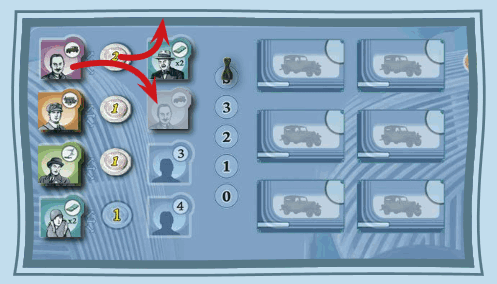
If four buyers have already been placed, the player
instead moves the marker token on the buyer track down one
space.
If all four active buyers have already been placed, the player
instead moves the marker token on the buyer track down one
space. If space 0 is reached in this way, there is a scoring after this
player turn, see 5.3.
The player conducting the buyer action may
not forego moving the marker token down.
Example: Four active buyers have already been chosen. Therefore
Marion now has to move the marker token one space down to “3”
with her buyer action.
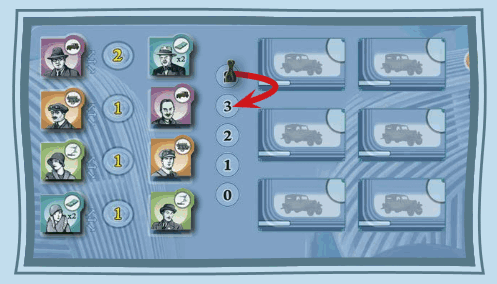
Grand-Prix
The player advances his race car the number of
spaces as the level of his race car engine.
Spaces occupied by cars of the other players are not counted.
With their race cars, the players drive one race
per game turn. One “worker” of each player
counts the laps. A lap begins at space 1 behind
the finish line and ends when it is crossed.
The value of the engine of the players´ Grand-Prix car is the
most important factor in a race.
Grand-Prix cars do not need a car body or “worker” to operate.
Each Grand-Prix action allows the player to advance his car as many
spaces as the value shown on the engine.
Important: Spaces occupied by cars of the
other players are skipped and are not counted.
In a game turn, a player starts his first Grand-Prix action
from the pit lane and moves to
space 1 with his first movement step. Each time
a player´s car crosses the finish line, the player advances his “worker” one
space on the round tracker.
Example: Marion´s car begins the race and moves two steps thanks
to its engine “2.” The blue car started earlier and occupies space 2.
Therefore Marion´s red car is allowed to skip that space and move
to space 3.
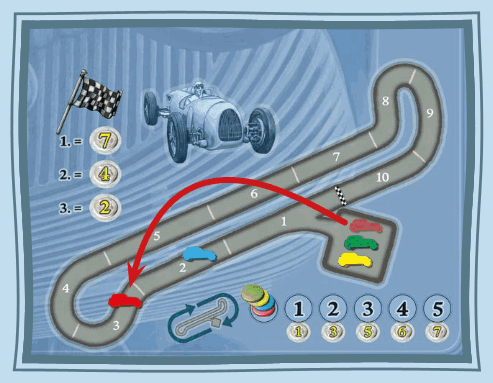
II. Moving a Kraftwagen (Car) to the Market
A player may move a car to the market at the end of his turn by placing the
following on an empty market space:
- A car body from one of his three workshops;
- An engine from one of his three workshops;
- At least one worker from his canteen;
- A colored price marker from the board; and
- A Horch or Mayback engineer marker (optional).
A player may move a car to the market at the end of his turn. He
needs the following to do so:
- A car body from one of his three workshops;
- An engine from one of his three workshops;
- At least one worker from his canteen (acting as service team);
-
One of the colored price markers that are next to the market.
The selected price marker sets the price of the car.
A player may freely choose which car body, engine, available price
marker, and the number of workers he takes from his canteen.
The player places all these elements as his “Kraftwagen” together
on an empty space on the market. The values and the number of
workers should be easily visible to all players.
Finally, the player may place one engineer marker on the
Kraftwagen if he has a suitable engineer.
Once placed, a car on the market may never be changed.
EXCEPTION: Rudolf Diesel may be used to change one
component as described below.
If a player places the sixth car on the market, the action phase
ends after that player’s turn and the scoring phase begins.
Example: Marion moves the third car to the market. It is
a BMW Dixi with a car body of value 3, an engine of value 4,
a service team of two workers and a price marker of 8.
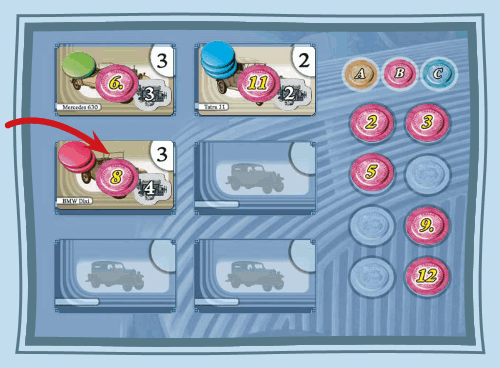
5.3 Scoring
Score after a player's turn in which he places the sixth car in the market or
moves the buyer track marker token to space 0.
Scoring has two parts, namely scoring the Grand-Prix race and scoring the buyers.
Scoring may be initiated in one of two ways: via the sixth car being
placed on the market or the marker token reaching space 0 on the
buyer track. In both cases, the current player ends his player turn,
then all players conduct scoring, consisting of two parts:
- Scoring of Grand-Prix Race
- Scoring of Buyers
I. Scoring of Grand-Prix Race
Points for relative position:
- 1st place: 7 points
- 2nd place: 4 points
- 3rd place: 2 points
Points for number of laps:
- 1 lap: 1 point
- 2 laps: 3 points
- 3 laps: 5 points
- 4 laps: 6 points
- 5 laps: 7 points (for each additional lap +1 point)
Return the cars to the pit lane and set all lap counters to zero.
The first three places in the Grand-Prix race are
determined, and players receive white price markers
from the supply as follows:
- 1st place: 7 points
- 2nd place: 4 points
- 3rd place: 2 points
Players then receive white price markers according to
the number of laps their car has completed on the track:
- 1 lap: 1 point
- 2 laps: 3 points
- 3 laps: 5 points
- 4 laps: 6 points
- 5 laps: 7 points (for each additional lap +1 point)
The players take the respective white price markers from the
supply next to the game board.
The cars are now placed back into the pit lane as the
players will be starting a new race in the following
turn.
II. Scoring of Buyers
In activation order each active buyer purchases
one car according to his preference:
-
Car Body: The lowest priced car among those whose car body has the
highest number.
-
Engine: The lowest priced car among those whose engine has the highest
number.
-
Prestige: The lowest priced car among those which have the largest
number of workers.
-
Price: The lowest priced car.
If a car has been sold, the owner takes its colored price marker.
If a car has been sold to a buyer with price preference,
the owner also takes a white price marker of the same value.
After all active buyers have purchased a car, remove all cars
from the market. Car bodies, engines, and workers are returned to the supply.
Any engineer markers on the cars are out of the game.
All active buyers in the order from 1 to 4 (and
potential fifth buyer from engineer Benz) purchase
one car each. Each buyer has a specific preference.
-
Car Body: The car whose car body has the
highest number is preferred by this buyer.
-
Engine: The car whose engine has the highest
number is preferred by this buyer.
-
Prestige: The car which has the largest
number of workers (=servicemen) is preferred
by this buyer.
-
Price: The car which is least expensive is
preferred by this buyer.
If only one car has the highest value of the buyer’s respective
preference, the buyer will buy that car. If multiple cars share the
highest value of the buyer’s preference, the buyer purchases the
car with the lowest price among them.
The decision of a buyer therefore is done in two steps:
A buyer with the price preference only decides via the price.
If a car has been sold, the owner takes its colored price marker and
places it face-down in front of himself. If a car has been sold to a buyer
with price preference, the owner takes an additional white price
marker of the same value as the colored price marker on the car
from supply and places it face-down in front of himself.
Example: The active buyers now purchase cars. The first buyer
purchases the blue Tatra 11 because it has the largest prestige thanks to
three workers. The blue player takes the price marker “11” and places it
face-down in front of himself. The second buyer chooses the green Mercedes
630. Marion’s BMW Dixi also has a car body of the same value “3,”
however the Mercedes price can’t be beat, so the green player takes the
price marker “6” and places it face-down in front of himself. Marion sells
her BMW Dixi to the third buyer with engine preference and takes the
price marker “8” and places it face-down in front of herself.
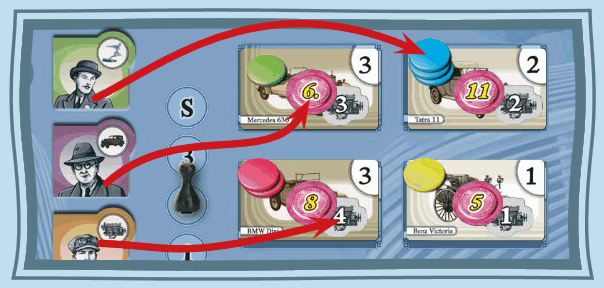
After all active buyers have purchased a car, all cars are removed
from the market no matter if they have been sold or not. Car
bodies, engines, and workers are returned to the supply next to
the gameboard. Any used engineer markers are out of the game
and are returned to the game box.
Colored price markers that have not been
taken are removed and put into the supply
of white markers. They may be used in future turns in lieu of white
markers. All active buyers are returned to their stacks.
Now the second or third game turn is prepared.
A player receives an award tile when he is the first to fulfill its requirement.
During the game, the players may receive various award tiles.
To get an award tile, a player must be the first to fulfill its
requirement. The player then takes the respective award tile and
places it face-down in front of himself.
The following award tiles are included in the game:
Grand-Prix Race
Complete one or two laps on the racetrack.
If the player is the first to complete one or two laps on the
racetrack, he gets the corresponding marker worth 3 or 7 points.
Buyer
Activate the second buyer of one category/preference.
If the player is the first to choose the second buyer of
one category/preference and places him in the row of
active buyers, he gets the tile worth 3 points.
Note: This may be triggered by engineer Benz.
Example: There is already one buyer with the engine preference in
the row of active buyers. Marion now chooses the second buyer with
this preference and receives the award tile.
Market
Have two cars in the market.
The first player placing his second car on the market
receives this tile worth 3 points.
Car Body
Have a car body of at least level 3 or 6 in a workshop
When the first player places a “3” or “6” car body into his workshop, he
receives the tile worth 3 or 7 points, respectively. The player also receives
the tile if he immediately builds a car body of higher value than
required. In the very rare case that a player immediately places
a “6” car body into his workshop, he receives both tiles.
Note: An upgrade from an engineer marker does not count here.
Engine
Have an engine of at least level 4 or 7 in a workshop.
When the first player places a “4” or “7” engine into his workshop, he
receives the tile worth 3 or 7 points,
respectively. The player also receives the tile if he immediately builds
an engine of higher value than required. In the very rare case that a
player immediately places a “7” engine into his workshop, he receives
both tiles.
Note: An upgrade from an engineer marker does not count here.
Workers
Have no more workers left in the supply.
If a player has all his workers in play (i.e., there are
none of his workers in his supply), he receives the tile
worth 7 points.
Engineers
Have three three engineers.
If a player “owns” three engineers he receives this
tile worth 7 points.
Set Up: Sort the tiles by game turn (A, B, & C). Shuffle the four tiles for
each game turn separately and place them in three face down stacks.
Place the A-tile on the top of the A Stack in front of
the tile showing three actions on the action track.
General Rules: All standard rules are in effect. After a player takes a specialty tile and performs its actions,
the tile is discarded and replaced by the next tile on the current game turn stack.
If all 4 tiles of the current turn’s stack have been used, reshuffle and restack them and place the top tile
from stack on the action track. When a bonus tile from a previous round is selected or passed
over by all players, discard it and replace it with the top tile from the stack for the current round.
Note: Players should agree whether to use these Specialty tiles before the start of the game. It is recommended
that these tiles not be added until after players have played the base game a couple of times.
Set Up: The tiles are sorted by game turn (A, B, & C). Then all four tiles for each game turn are shuffled and placed
face down in their respective stacks. The A-tile on the top of the A Stack is selected, flipped, and placed in front of
the tile showing three actions on the action track (it is now the 11th tile).
General Rules: All standard rules are in effect. When a player takes a special tile he immediately performs the
standard action (top of tile) and the bonus action (bottom of tile). The bonus actions are described below. The tile is
discarded and the next tile on the corresponding game turn stack is selected, flipped, and placed at the front of the
action track. If and when all 4 tiles of the current turn’s stack have been used, reshuffle them and place the top tile
from the new draw stack back on the action track. When a bonus tile from a previous round is selected or passed
over by all players, return it to the box and draw and place the first tile from the stack for the current round. Bonus
tiles from previous rounds will not be used again.
A TILES
The player takes a value 3 engine. His
engine research level does not matter.
The player receives one money
for each worker in his cantina.
The player replaces his Grand-Prix car
engine with an engine of the
next higher value. If he owns Bugatti, he
may immediately race.
The player may remove one of his
cars from the market and immediately
receives three money. The price marker
is placed back on the gameboard (it
may be reused); the engine, body and
workers are placed back in their pools.
B TILES
The player takes a value 5
car body. His body research
level does not matter.
The player replaces his Grand-Prix car engine with an engine of
the next higher value. If he owns
Bugatti, he may immediately race.
The player may sell one engine or one
car body from his factory. He receives
its value in money (e.g., a value 4 engine
would earn four money).
The player takes the top card of
the research card discard pile
and conducts a standard research
action with that card.
C TILES
The player may sell one engine or one
car body from his factory. He receives
its value in money (e.g., a value 4 engine
would earn four money).
The player receives one money
for each worker in his cantina.
The player takes a value 6 engine. His
engine research level does not matter.
The player may remove one of his cars
from the market and immediately
receives seven money. The price
marker is placed back on the gameboard
(it may be reused); the engine, body and
workers are placed back in their pools.
Developments
Players receive car body and engine research points
via Research development
cards. Research points determine the level of car bodies and
engines that a player can take via car body and engine actions.
If there is a car body or engine icon at the bottom of the card
then the player also takes a car body or engine from the supply.
At the start of the game, each player has one
research point in both categories from his start tile.
Players receive research points in the car body and
engine categories via Research development
cards. Some of the cards earn the player two
research points (the card contains either two car
bodies, two engines, or one car body and one
engine). Other cards immediately earn the player a
car body or engine from the supply (identical to the
respective action; please take a look at the icons at the bottom of
the card). The number of research points a player has determines
which car bodies and engines a player may take with the car body
and engine actions. At the start of the game, each player has one
research point in both categories from their respective start tile.
A player can have a maximum of 7 car body research points and 7 engine research points,
even if he has activated research cards that would give him more.
A player gains the benefits of a development card only when he activates it
by placing a worker on it.
The player MUST activate a development if possible.
If the player does not have a worker in his canteen, the card is
inactive until the player has a worker to place on the card.
The player MUST activate a development if possible. To do so,
he places a worker from the canteen onto the research card.
If the player does not have a worker in his canteen, the card is
inactive and will remain so until a worker is placed on the card.
The next time the player takes a worker from their supply, he
must immediately use him to activate the inactive development,
at which point the player receives the respective benefit.
If the research card allows taking a car body
and/or engine, the player may include new
research points immediately, if active.
Note: The start tile is active without a worker – the player
does not place a worker here.
Example: Marion already owns two active developments.
She has two research points in the car body category and
three research points in the engine category. Therefore, when
conducting the corresponding action, Marion may take a “2”
car body and a “3” engine from the supply.
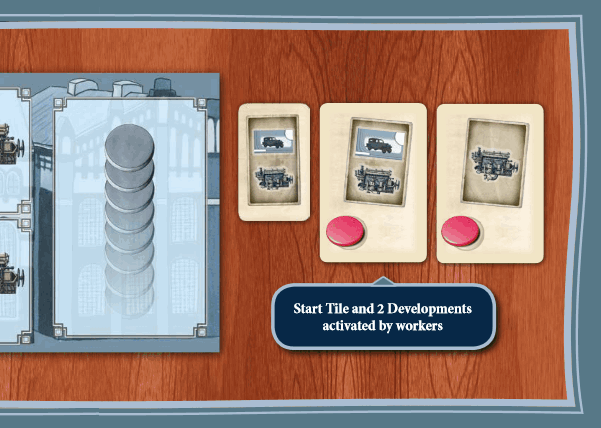
Instant actions
These cards are performed immediately.
Afterwards, the card is placed on the discard
pile. These cards include the following:
Hire three workers
The player takes up to three of his workers
from the supply and places them in his
canteen. If he has already taken all workers
from the supply, this action is forfeited.
Grand-Prix
The player immediately advances his car on
the race track by five spaces (the standard
“racing rules” are in effect; see below).
One car body & one engine
The player immediately receives one car
body and one engine according to his
research points in these categories.
Engineers
Each engineer has a special bonus. The
player puts the engineer card in front of
himself and keeps it until the end of the game.
Several engineers come with one or two engineer markers.
Note: A player may use only one Daimler or Diesel marker per turn
and only one Horch or Mayback marker per turn.
Adam Opel: Each time the player sells a car
to a buyer with the “price” preference, he
receives the threefold (instead of twofold)
price. He takes price markers from the
supply accordingly.
August Horch: The player takes two engineer
markers – “+1 engine” and “+2 engine.” When
he moves a car to the market, he may
add one of the markers to increase the
engine value during the next scoring
phase. Note: It is possible to increase
the value to more than 7 in this way.
Limit of 1 engine marker on a car.
Carl Benz: The player receives the engineer
marker “5th buyer.” Once, at the start of
scoring, he may discard this marker and
introduce another (fifth) buyer.
He places this buyer below the
already active buyers.
Note: Benz may earn the player the
award tile Buyer, see
6.0.
Ettore Bugatti: If the player installs a new
engine in his Grand-Prix car, he immediately
moves his car on the race track afterwards.
Note: The newly installed engine must be
of a higher value than the previous engine
on the Grand-Prix car. In addition, the
player always has to take and install the best
possible engine according to his research points.
Ferdinand Porsche: If the player chooses
the Grand-Prix action, he advances his car on
the race track by one additional space.
Note: This is also true for the instant action
of a research card and the bonus by Ettore Bugatti.
Gottlieb Daimler: The player receives the
two engineer markers “+2 buyer” and “+4
buyer.” He may use a single
marker once on his player turn
and place it on any active
buyer. A single buyer, however,
may only get one Daimlermarker,
not both. This buyer
increases the points for the sold car by +2 or +4.
Note: If this buyer is a buyer with the “price” preference, the
bonus is not doubled (or tripled with Opel).
Nikolaus August Otto: The player takes
up to two of his workers from the supply
and places them in his canteen. Afterwards
he immediately conducts another research
action. If there are no more workers in
supply, this part of the action is forfeited.
Rudolf Diesel: The player takes the two
engineer markers “change.” If he discards
one of these markers in his turn, he may
change one “category” of one of his cars
at the market (either car body, engine,
number of workers, or price).
Note: To do so, he takes a car body,
engine or worker(s) from his workshop
or canteen. If he would like to change the price, he exchanges
the price marker on the car with a colored price marker of
the turn still available next to the market.
On Yucata if the player uses a Diesel marker to reduce the prestige of the car or to change
the body or engine, return the removed workers, body or engine to the supply, not to
the player's canteen or workshop.
Wilhelm Maybach: The player
receives the two engineer markers
“+1 car body” and “+2 car
body.” He may use one of these
markers when he is moving a car
to the market to increase the
value of the car body during the next scoring.
Note: It is possible to increase the car body
value to more than 7 in this way. Limit of 1 body marker on
a car.